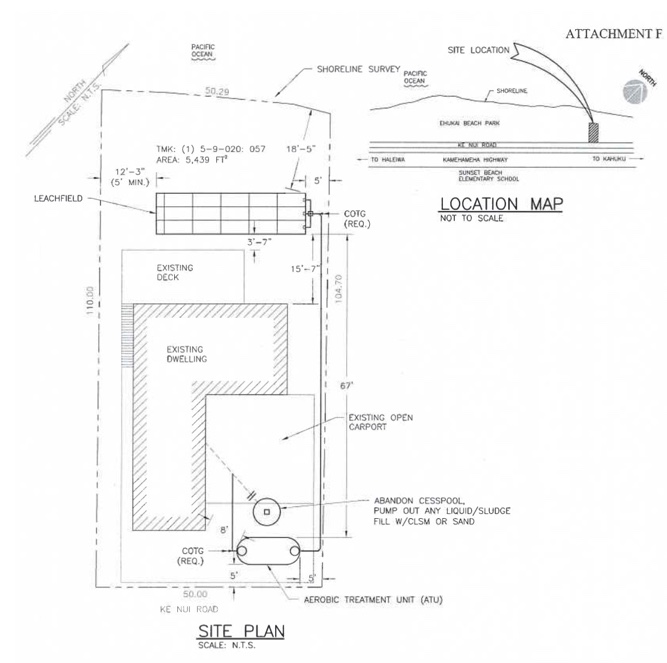Late last year, Justin Prouty purchased an ocean-front home for $2.7 million on Ke Nui Road, on O‘ahu’s North Shore. The area, known as Sunset Beach, is famous for its surf – but also for the high winter waves that have eroded the coast, effectively moving houses on Ke Nui and nearby areas ever closer to the water.
A year earlier, in 2019, the property was one of nearly two dozen in Haleiwa and nearby Pupukea that had obtained permission from the state Department of Land and Natural Resources to install temporary emergency sandbag berms along the eroding scarp.
Now, as Prouty plans to add an additional bedroom and den to the house, he must replace the existing cesspool that serves the property with a more modern aerobic treatment unit that disperses partially treated waste into a leach field.
Under Department of Health rules, leach fields need to be set back from the shoreline a minimum of 50 feet. Complying with the setback requirement is not possible, given the small back yard of Prouty’s house lot. And so Prouty’s engineer, Michael McNulty, prepared an application for a variance from DOH setback requirements, which was submitted to the DOH Wastewater Branch inearly July.
On July 7, the Honolulu Star-Advertiser carried a public notice of the variance application, and Environment Hawai‘i obtained a copy of it a few days later.
Plans for Prouty’s leach field show there’s at most 18.5 feet between the outermost edge of the planned leach field and the shoreline.
In addition to the 50-foot setback between the outermost reach of the leach field and the shore, DOH rules also require a minimum of 5 feet between the leach field and structures. As shown on the site plan accompanying the Prouty variance application, just 3.7 feet lie between the mauka wall of the most mauka trench of the leach field and the makai edge of a deck. The makai wall of the house is another 12 feet further inland from the outer boundary of the deck.
Sina Pruder, head of the Wastewater Branch, was asked if her staff was able to confirm the distances provided in the application. “DOH relies on the licensed engineer to provide the information about the shoreline certification when submitting a variance and/or individual wastewater system application,” she replied.
At present, she noted, the house at 59-297 Ke Nui Road “is currently a 3 bedroom/2 bath home that is connected to a cesspool that is at least 10 feet deep. When designing individual wastewater systems, we use 200-gallons-per-day for a bedroom. Based on that information, the existing design flow of the cesspool is … 600 gpd. The owners plan on adding another bedroom and a den, which we consider a bedroom-like room, so the design will be 5 bedrooms x 200 gpd = 1,000 gpd.”
Given this, Pruder was asked, should the Department of Health require current certified shorelines be included in applications for wastewater variances along the coast?
“As a condition of the variance,” Pruder replied, “we’ll request that a certified shoreline survey shall be submitted with the individual wastewater system application. We’ll actually include this as a condition for future variances with similar situations.”
Although McNulty’s application did not note a certified shoreline on the site plan, after he was asked about this, he provided Environment Hawai‘i with a copy of the certified shoreline map as accepted by the Department of Land and Natural Resources in early July.
As determined by the most recent survey, the shoreline is well mauka of a certified shoreline surveyed in 1990, and even further mauka of a survey made in 2015.
Dr. Shellie Habel, coastal lands program coordinator with Sea Grant at the University of Hawai‘i, noted that the shoreline in that area is known to experience seasonal erosional/accretion patterns. “Just because it’s wide now doesn’t mean it’s always wide,” she told Environment Hawai‘i. The Department of Health should factor that in, “in addition to at least near-term projects of sea level rise.”
— Patricia Tummons


Leave a Reply